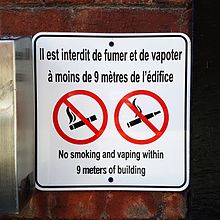
Smoking bans, or smoke-free laws, are public policies, including criminal laws and occupational safety and health regulations, that prohibit tobacco smoking in certain spaces. The spaces most commonly affected by smoking bans are indoor workplaces and buildings open to the public such as restaurants, bars, office buildings, schools, retail stores, hospitals, libraries, transport facilities, and government buildings, in addition to public transport vehicles such as aircraft, buses, watercraft, and trains. However, laws may also prohibit smoking in outdoor areas such as parks, beaches, pedestrian plazas, college and hospital campuses, and within a certain distance from the entrance to a building, and in some cases, private vehicles and multi-unit residences.

Smoking in Argentina accounts for 15% of total tobacco consumption in the Americas. In the 20th century, the government promoted settlement and economic development in the northern subtropical zones, with tobacco playing a central role. A new government agency worked to educate farmers and promote the cultivation, processing, and marketing of tobacco. While tobacco factories were initially concentrated around Buenos Aires, they gradually extended into the northern production regions. By 1960, Argentina accomplished self-sufficiency in tobacco production. By the 1970s, its annual output exceeded 60,000 metric tons, with one-third exported. At the local level cooperatives are active, they sell to one of two multinational companies, Nobleza-Picardo, an affiliate of the British American Tobacco company, and Messalin-Particulares, associated with Philip Morris International. Argentina held the global rank of third place in terms of production, trailing behind Brazil and Mexico.

Because of the damage to health due to smoking in the United Kingdom it may be the first country to ban sales of cigarettes to people born after 2008.

The New Jersey Smoke-Free Air Act is a comprehensive smoking ban that took effect in New Jersey on April 15, 2006. The law prohibits smoking in most workplaces as well as in indoor public areas. The Act has been amended a number of times including in 2009 to extend the ban to electronic smoking devices and in 2018 to extend the ban to public parks and beaches. A notable exception to the smoking ban is in casinos, but legislation to remove this exception is currently pending in the New Jersey Legislature. The New Jersey Smoke-Free Air Act also allows municipalities to enact their own restrictions on smoking.
The loi Évin is the French alcohol and tobacco policy law passed in 1991. It takes its name from Claude Évin, then Minister of Health, who proposed it to Parliament.
The Tobacco Products Control Act was introduced in South Africa in 1993, where smoking has been rated the second highest health concern, after HIV/AIDS.

The use of tobacco for smoking in New Zealand has been subjected to government regulation for a number of decades. On 10 December 2004, New Zealand became the third country in the world to make all indoor workplaces including bars and restaurants smoke-free. The smoking rate in New Zealand was about 8% as of 2023 when the new government planned to eliminate the nation's smoking ban to fund tax cuts.
Smoking in China is prevalent, as the People's Republic of China is the world's largest consumer and producer of tobacco. As of 2022, there are around 300 million Chinese smokers, and 2.4 trillion cigarettes are sold there every year, 46% of the world total.
Smoking in France was first restricted on public transport by the 1976 Veil law. Further restrictions were established in the 1991 Évin law, which contains a variety of measures against alcoholism and tobacco consumption. A much stronger smoking ban was introduced on 1 February 2007. Smoking in enclosed public places such as offices, schools, government buildings and restaurants is strictly prohibited. Law officials may enforce the laws with minimum fines set at €500.

SmokinginCanada is banned in indoor public spaces, public transit facilities and workplaces, by all territories and provinces, and by the federal government. As of 2010, legislation banning smoking within each of these jurisdictions is mostly consistent, despite the separate development of legislation by each jurisdiction. Notable variations between the jurisdictions include: whether, and in what circumstances ventilated smoking rooms are permitted; whether, and up to what distance away from a building is smoking banned outside of a building; and, whether smoking is banned in private vehicles occupied by children.
Smoking in Ireland is banned fully in the general workplace, enclosed public places, restaurants, bars, education facilities, healthcare facilities and public transport. However, it is permitted in designated hotel rooms and there is no ban in residential care, prisons and in outdoor areas. Public opinion is in favour of the bans on smoking imposed in Ireland.
Tobacco is an agricultural product acting as a stimulant triggering complex biochemical and neurotransmitter disruptions. Its main ingredient is nicotine and it is present in all cigarettes. Early tobacco usage was for medical cures and religious purposes. In the early 1900s, cigarette usage became increasingly popular when it was sold in mass amounts. In 1964, the Surgeon General of the United States wrote a report concerning the dangers of cigarette smoking. In the United States, for the past 50 years efforts have been made so that the public should be aware of the risks of tobacco usage.

Smoking in Greece was at the highest rate of tobacco consumption in the European Union in 2010. In 2014, Greece had the highest rate of smoking in the European Union. According to a survey published by the European Commission Day for World No Tobacco Day in 2017, 37% of Greeks are smokers and only 44% of Greeks have never smoked a cigarette, the smallest percentage in the EU. After Greece, France and Bulgaria have the next largest number of smokers with 36%. At 7%, Sweden had the lowest rate.

Regulation of electronic cigarettes varies across countries and states, ranging from no regulation to banning them entirely. As of 2015, around two thirds of major nations have regulated e-cigarettes in some way.

A vape shop is a retail outlet specializing in the selling of vaping products, though shops selling derived psychoactive cannabis products have increased since the passage of the 2018 Farm Bill. There are also online vape shops. A vape shop offers a range of vaping products. The majority of vape shops do not sell vaping products that are from "Big Tobacco" companies. In 2013, online search engine searches on vape shops surpassed searches on e-cigarettes. Around a third of all sales of vaping products take place in vape shops. Big Tobacco believes the independent vape market is a threat to their interests.
Smoking in Chicago is regulated by the Smoke Free Illinois Act since 2008 as well as its own Clean Indoor Air Ordinance since 1988 and the Chicago Clean Indoor Air Act from 2014.
The Oregon Indoor Clean Air Act, also known as the Smokefree Workplace Law, is a measure passed in 1981 by the US State of Oregon prohibiting smoking in public indoor places except in certain designated smoking areas. The objective is to protect non-smokers in confined areas from second-hand smoke. Beginning on January 1, 2016, the law was extended to cover "inhalant delivery systems" such as e-cigarettes.










